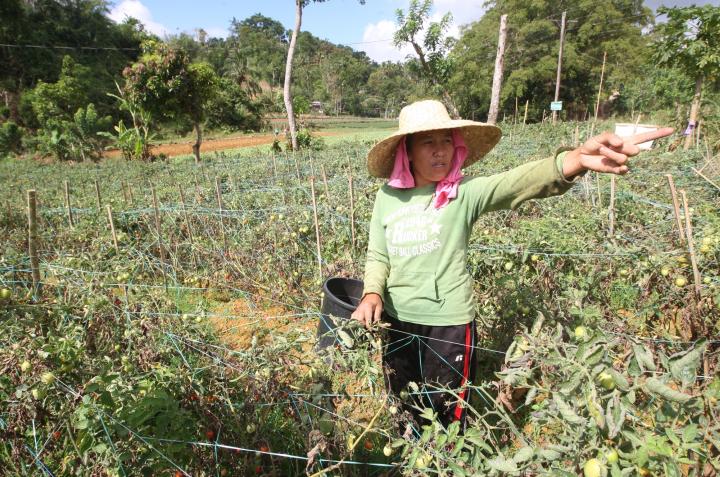‘If springs dry up, we’re in trouble’

A farmer gestures in the middle of her plots of tomatoes. (CDN PHOTO/ TONEE DESPOJO)
The summer heat is taking its toll on farmers in Cebu City’s 31 upland barangays.
Leonora Rabago, 34, and her husband rely on a spring in a nearby small cave to water their farm planted with lettuce and onions in sitio Satuhan, barangay Sudlon II.
Many pump water from the spring and use a hose to sprinkle directly on the crops, she said.
“Medyo naapektahan na gyud ang tubig sa kainit. Nihubas na siyag sugod (We are starting to be affected by the heat. The spring’s water level is getting lower.)
Lettuce is the number-one cash crop of Sudlon II and needs a lot of water to thrive.
Rabago said they had just harvested some of their lettuce last month. The rest will be ready by May.
Water drums
“Basta kay dili lang gyud mohubas ang tubod, okay ra mi. Kay kung mohubas ang tubig, wa gyud miy mahimo (As long as the spring doesn’t completely dry up, we’re okay. If it goes dry, we can’t really do anything),” she said.
She said they have no drums or impounding facilities to store water. Their lone plastic drum is used to hold fertilizer.
The farmer-couple are tilling their own land and buy their own seeds.
Since they don’t belong to any farmers’ associations, they were not a beneficiary of City Hall’s agricultural aid.
Last Wednesday, Cebu City Councilor Margot Osmeña asked what happened to an P11-million budget approved by the City Council for the purchase of drums, hoses and other materials to help farmers in upland areas cushion the effects of a mild El Niño and the dry season this year.
The city agriculture office said part of the P5 million they requested for agriculture inputs in the dry season are being distributed through farmers’ associations.
Main source
Other farmers like couple Kent and Victoria Albores of sitio Balao, Sudlon II share their water hoses with others.
They roll up the plastic hoses in case fellow-farmers in the barangay ask to borrow it.
The couple and their family live a few meters from a small river which is their main source of water for their ginger, cucumber, beans and lettuce plots on the mountain slope.
READ: Margot asks where P11 million budget for farm aid went
Victoria said they’re lucky that the river still has a lot of water and shows no sign of drying up.
Some farmers said the heat they’re presently experiencing is normal and part of the dry season.
Instructions
“Medyo niinit na gyud pero para namo normal ra gihapon ni basta summer (It’s really becoming hotter but for us, it’s just normal here if it’s summer),” said 34-year-old Jocelyn Sarte, who works for a private owner of a tomato and eggplant farm in sitio Satuhan in barangay Sudlon II.
But she said she’s worried that they may have problems with the crops if the hot weather persists until June or July.
Asked how they are preparing for this scenario, she said they will just wait for instructions from the farm owner.
Still others consider it a good situation.
Edwin Castro, who works for a mango plantation in sitio Gaang in barangay Bonbon, said the hot weather induced their trees to blossom earlier than usual.
“Usually, we need to bombard it with chemicals for it to bloom but now, it bloomed on its own because of the heat,” he said. The mango blossoms are on its 26th day.
Adjustments
Castro said by the 30th day, the trees will start bearing fruit and it’s time to wrap them up.
By the 110th day, he said the fruits are ready for harvest.
He said they’re thankful that it still rains however briefly at night.
Still, they had to make adjustments because of the hot weather.
They were spotted by the CDN news team using a water pump to bring water from a stream some distance from their plantation since the spring they usually get their water from had dried up.
A farmer waters his young lettuce plants in barangay Sudlon II, Cebu City at the onset of a hot summer. (CDN PHOTO/ TONEE DESPOJO)
They stored the water in plastic drums and loaded them onto a multicab.
Using a pump and hose, they sprayed the water on the mango trees.
Cebu City agriculturist Joey Baclayon said the dry spell in the city’s upland barangays was normal.
“It’s a normal situation during summer. It’s not alarming. There’s still water,” he said.
Scattered rains
Baclayon said it’s a good thing that there are still scattered light rain showers at night.
The Department of Environment and Natural Resources (DENR) is asking the public to conserve water and avoid cutting down trees and burning leaves.
DENR information officer Eddie Llamedo said drivers and tourists should dispose of their lighted cigarette butts properly so they won’t start grass fires that may spread.
Three years ago, the DENR recorded a fire outbreak at a watershed area in Buhisan Dam caused by a lighted cigarette butt thrown by a habal-habal driver passing by the area.
Last week Baltazar Tribunalo, Provincial Disaster Risk Reduction and Management Office (PDRRMO) chief, said he was disappointed with the slash-and-burn farming or kaingin still being practiced by farmers in the towns of Balamban, Asturias, Tuburan and some parts of Cebu City.
He said the Cebu provincial government will conduct an information drive to curb the illegal practice.